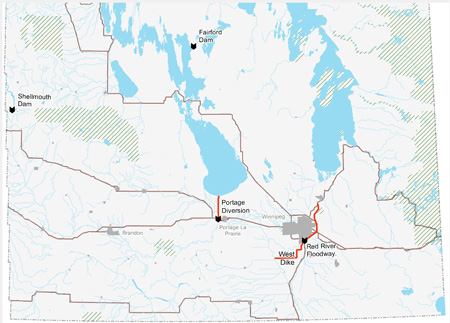Flood Control Infrastructure
Southern Manitoba has extensive flood control measures in place, particularly in the Red River Valley, from Winnipeg, south to the U.S. border. Flood controls were built after the devastating flood of 1950, which flooded the Red River Valley and the City of Winnipeg. Construction of the Red River Floodway, the Portage Diversion and the Shellmouth Dam and Reservoir began in the mid 1960's. Additional flood control improvements, including an expansion of the floodway, were made after the 1997 flood. This flood was substantially larger than the 1950 flood, but resulted in far less property damage because of the flood control measures in place. There are also flood control measures along the Assiniboine River.
The largest flood in the recorded history of Manitoba took place on the Red River in 1826 and was 40 percent larger than the 1997 flood. It is estimated that a repeat of an 1826 level flood without the Floodway would result in more than $5 billion in damages for the province.
Flood protection work has prevented property damage and reduced the potential impact of flooding on families and communities. Since the 1997 flood, more than $1 billion has been invested in flood mitigation efforts in Manitoba. This investment has prevented over $7 billion in damages throughout Manitoba.
The 2011 flood affected a large geographic area and thousands of Manitobans. Early flood forecasts and flood-mitigation efforts helped many communities get a head start on protecting homes and lands, but damage was still widespread.
The following structures are operated by the Hydrologic Operations Branch:
- Red River Floodway
- Portage Diversion
- Fairford River Water Control Structure
- Shellmouth Dam and Reservoir
Due to the multi-purpose nature of the Shellmouth Dam and Reservoir, the structure is operated by the Hydrologic Forecasting and Water Management mid-Division.

Location of the Red River Floodway, the Shellmouth Dam, the Portage Diversion and
the Fairford River Water Control Structure


